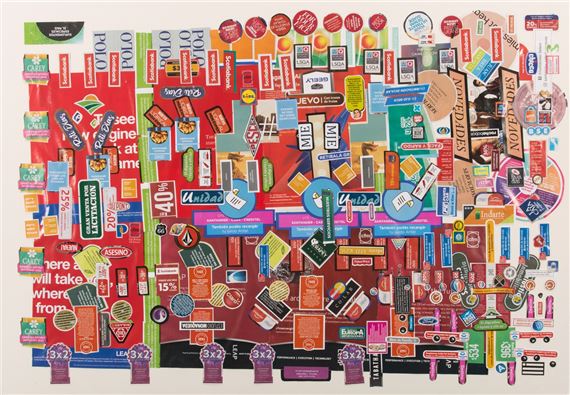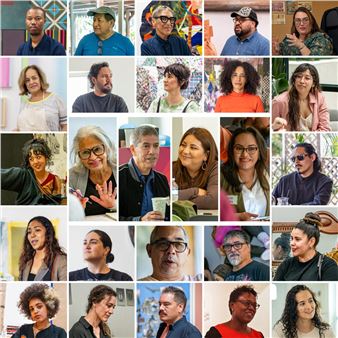Dani Umpi: Goblin Tasks
Over the years, we have crossed paths with Brazilian writer Maria Alzira Brum at art or book fairs. Distant events. Other encounters we have provoked ourselves, weaving our network of affinities around the theorization and fantasies surrounding the archetype of the goblin. Only an goblin can recognize another goblin. Goblins laughing at their own name. Both of us have always been told that we seem like goblins.
Whenever we can, we branch out into a constantly evolving theory about the ãgoblinãs craft.ã What would it be? A book. A collage. A deformed bush as a metaphor for our creation and others; as a way to read creative processes, a form of relating, a speculative philosophical wildcard, playful, a way of life. It appears and disappears.
Goblins are, above all, language. Mutant forms of organizing, producing, and reading texts. ãFigures that are texts. Texts that are figures,ã that is Maria Alziraãs thesis. I think more about the Goblin that moves errantly on the borders, the elusive, the evasive, the intermediary, a translator between planesãÎ I lean more toward that side without losing sight of the Goblinãs main goal: Guardian of matter. Custodians of hidden treasures. Traps. Distractions. Hermit and adventurer. A tightrope walker between uselessness and treasure, between the minute detail and expansive fantasy. It changes the value of things. Elevating the insignificant to the category of jewel or stripping away the importance of what was once considered sacred. How eager to bother!
For years, my artistic self-perception was anchored in the archetype of the Fool, inhabiting, conceptualizing, and creating from that role. It was a very interesting experience until I began to pay attention to the Goblin, a neighboring archetype, with less of a moralizing burden. One thing led to another, but the Goblin intervenes. It makes double movements. On one hand, it can be understood as an impetuous creation from the earth, from a specific place. But it also represents the transitory. A place of escape. A shifting territory with uncertain coordinates.
The Fool, in its predictability, is marked by drama, by the place it holds in society, the space it is allowed to act in, and all that. People who work with humor understand this perfectly. The Goblin is a little more elusive. It doesnãt need the ãboom,ã the resolution. The Goblin is a more fluid and dynamic figure, moving between anxiety and creative energy, constantly changing and in transition. This makes it a vital force. The Goblin is rotating, changing, not definitive. The Fool is trapped. The Goblin, by not being catchable (but still entering and exiting), brings into play the unpredictable, the creative spark. Without this, everything feels stifling. The Goblin doesnãt like that at all.

Recommended for you
Over the years, we have crossed paths with Brazilian writer Maria Alzira Brum at art or book fairs. Distant events. Other encounters we have provoked ourselves, weaving our network of affinities around the theorization and fantasies surrounding the archetype of the goblin. Only an goblin can recognize another goblin. Goblins laughing at their own name. Both of us have always been told that we seem like goblins.
Whenever we can, we branch out into a constantly evolving theory about the ãgoblinãs craft.ã What would it be? A book. A collage. A deformed bush as a metaphor for our creation and others; as a way to read creative processes, a form of relating, a speculative philosophical wildcard, playful, a way of life. It appears and disappears.
Goblins are, above all, language. Mutant forms of organizing, producing, and reading texts. ãFigures that are texts. Texts that are figures,ã that is Maria Alziraãs thesis. I think more about the Goblin that moves errantly on the borders, the elusive, the evasive, the intermediary, a translator between planesãÎ I lean more toward that side without losing sight of the Goblinãs main goal: Guardian of matter. Custodians of hidden treasures. Traps. Distractions. Hermit and adventurer. A tightrope walker between uselessness and treasure, between the minute detail and expansive fantasy. It changes the value of things. Elevating the insignificant to the category of jewel or stripping away the importance of what was once considered sacred. How eager to bother!
For years, my artistic self-perception was anchored in the archetype of the Fool, inhabiting, conceptualizing, and creating from that role. It was a very interesting experience until I began to pay attention to the Goblin, a neighboring archetype, with less of a moralizing burden. One thing led to another, but the Goblin intervenes. It makes double movements. On one hand, it can be understood as an impetuous creation from the earth, from a specific place. But it also represents the transitory. A place of escape. A shifting territory with uncertain coordinates.
The Fool, in its predictability, is marked by drama, by the place it holds in society, the space it is allowed to act in, and all that. People who work with humor understand this perfectly. The Goblin is a little more elusive. It doesnãt need the ãboom,ã the resolution. The Goblin is a more fluid and dynamic figure, moving between anxiety and creative energy, constantly changing and in transition. This makes it a vital force. The Goblin is rotating, changing, not definitive. The Fool is trapped. The Goblin, by not being catchable (but still entering and exiting), brings into play the unpredictable, the creative spark. Without this, everything feels stifling. The Goblin doesnãt like that at all.

 ARTISTS
ARTISTS









